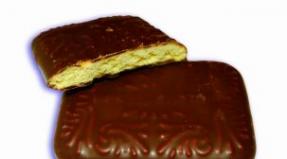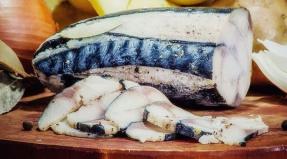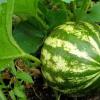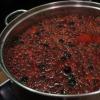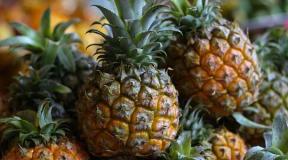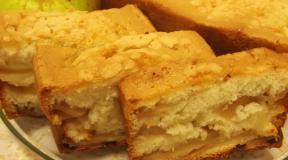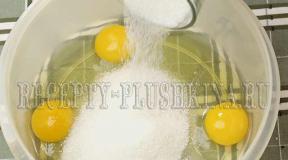Solubility of sorbic acid in water. The benefits and harms of food additive E200 - sorbic acid
Sorbic acid-based preservatives - sorbic acid itself (E200), potassium sobat (E202) and calcium sorbate (E203) - are successfully used in the production of almost all food products (Table 1), including weakly acidic ones. For example, adding 0.2% sorbic acid to butter cream allows to increase the shelf life of cream cakes and pastries at a temperature of 2-8 C from 36 to 120 hours (OST10-060-95 "Cakes and pastries"); processing loaves of semi-smoked sausages with a concentrated solution of potassium sorbate increases the shelf life without mold growth by 4 times; margarine containing sorbic acid is stored at a temperature of 6-8 C for at least 2 months instead of the usual 20 days (GOST 240-85 "Margarine").
Table 1. Approximate doses of interchangeable preservatives in food products.
| Product | ||
| Butter, margarines | 30-60 | |
| Butter, margarines | - | 60-120 |
| Mayonnaise, mustard, ketchup | - | 100-200 |
| cheeses | 60-100 | - |
| fish products | 100-200 | - |
| Smoked meats, smoked sausages | 200-400 | 200-400 |
| Boiled sausage | 50-80 | - |
| Canned vegetables | - | 100-200 |
| Sauerkraut | - | |
| Tomato puree, 12% | - | 50-150 |
| Jams, preserves, preserves, etc. | 50-150 | 70-200 |
| Fruit and berry puree | 50-60 | 50-60 |
| Fruit fillings for baking | - | 150-200 |
| Fruit preparations for yoghurts and other dairy products | - | 100-150 |
| Apple juice semi-finished product | ||
| Grape juice - semi-finished product | 50-60 | 65-80 |
| Fruit juice concentrates | - | 100-200 |
| Soft drinks | - | 40-60 |
| Carbonated soft drinks | - | 30-40 |
| Herbal infusions, tea, coffee | - | 40-60 |
| Low alcohol wines | - | 20-30 |
| Non-alcoholic wines | - | |
| Sugar confectionery (sweets, waffle fillings, nougat, praline, chocolate) | 80-50 | 150-200 |
| Flour confectionery (yeast-free) | 100-200 | 130-200 |
| Confectionery semi-finished products (dough) | 200-300 | - |
| Butter cream | ||
| Bread and bakery products | 150-200 | - |
* joint use of sorbic acid and potassium sorbate;
* grams per 100 kg of minced meat;
* grams per 100 liters of brine;
* grams per 100 kg of flour (Panosorb is used)
There are special forms of preservatives based on sorbic acid (Panosorb) and potassium sorbate (Vinosorb), used in order to avoid undesirable technological effects when preserving bakery products and wines, respectively.
Panosorb is a preservative for bakery products. Panosorb is a special form of sorbic acid that dissolves slowly during dough preparation without affecting fermentation.
Panosorb prevents the development of microorganisms during storage of bakery and bakery products (slows down mold growth), without inhibiting the effect of baker's yeast during fermentation and proofing.
Recommended areas of application: any yeast baked goods. Bakery, bread, butter, puff, crackers, etc. Dosage: 0.15-0.2% by weight of the product. Dosage for tin bread made of premium flour from 0.1-0.2% by weight of the product. Dosage for puff yeast dough 0.1% by weight of the product. Dosage for rye dough 0.2% by weight of the product. Changing the dosage does not affect the proofing process or the baking process.
Mode of application: the calculated amount of Panosorb for the sponge and bezoparnoy production method is introduced into the dough together with flour. When preparing the dough periodically, it is recommended to pre-mix Panosorb with a small amount of flour to be kneaded, then add to the remaining flour, mix and use it when kneading. With continuous dough preparation, Panosorb is served together with flour that is used to knead the dough.
| Vinosorb new |
To prevent secondary fermentation during cold sterile filling
Product description
Organoleptically neutral, special pearl white product for wine stabilization. Potassium sorbate E 202. For food products (limited use): any use should be carried out in accordance with the normatively accepted maximum dosage of 270 mg of Vinosorb new product per 1 liter. Vinosorb new is the potassium salt of sorbic acid, a low molecular weight fatty acid. These fatty acids are found in natural foods. Potassium sorbate is also used as a harmless preservative in a number of foods.
The product is approved for use in accordance with the currently valid legal regulations.
Purity and quality are guaranteed by specialized laboratories.
Purpose of processing
Prevention of secondary fermentation in the bottle. Inhibitory effect on yeast and mold (not bacteria).
Product and its action
In the process of bottling, Vinosorb new protects against yeast and fungi for a long time. For this purpose, Vinosorb new has been successfully used for many years in 35 countries of the world in which viticulture is developing - to prevent secondary fermentation in the bottle. In principle, this product is effective only against fungi and yeast, not against bacteria. Therefore, he cannot reverse the standard stage of sulfitation, which simultaneously has a bactericidal and antioxidant effect. 134 mg of potassium sorbate is equivalent to 100 mg of sorbic acid.
Application
The recommended and maximum allowable dosage is 27 g of product per 100 l, i.e. 270 mg / 1 l of final product. A solution of Vinosorb new is added directly to the tank, with obligatory stirring for thorough distribution. Preliminary dissolution of the preparation in a small volume of wine is not recommended. It is preferable to add vinosorb directly to the tank when blending. In this case, it is necessary to strictly verify the content of free SO2, which should be constant at the desired concentration. Wine must have a constant free SO2 content of at least 40 mg / l. The introduction of Vinsorb new should be done, if possible, 24 hours before bottling, to ensure an even distribution in the wine.
Storage
Protect from moisture and foreign odors. Seal opened containers immediately and tightly.
Sorbic acid preservatives are effective against yeast, mold and some bacteria in almost all types of food, but their spectrum of antimicrobial action is still limited. Therefore, in a number of products it is recommended to combine them with other preservatives. Particularly effective is the combined use of potassium sorbate with sodium benzonate (in non-alcoholic drinks, ketchup, mayonnaise, fish products, vegetable and fruit preservatives). An additional additive of nisin (a substance that suppresses the acutely resistant bacteria to sorbic acid) is also used for processed cheeses and canned food.
It is difficult to imagine the modern food industry without additives. These include sorbic acid, the benefits and harms of which have been carefully studied by specialists. If used correctly, the additive will greatly simplify the work with dishes and preparations that require long-term storage. However, the abuse of sorbic acid can negatively affect the state of the body.
Sorbic acid - description and characteristics of the substance
Initially, sorbic acid was a natural preservative extracted from rowan juice. With the growth of industrial appetites, the additive began to be synthesized artificially, which affected its physical and chemical properties, but made it possible to reduce its cost.
Sorbic acid crystals are small, colorless and odorless. The substance is not carcinogenic and has no toxic properties. It is insignificantly soluble in water and has many properties. Sorbic acid is used in various fields of industry, but it is best known as a food additive, which in the international classification has received the designation E200.
Advice
Sorbic acid only slows down the development of pathogenic microorganisms, and does not destroy them. Therefore, it is pointless to try to use a supplement to restore already tainted foods. Their quality will not be improved by the presence of a chemical reagent.
The main effect of sorbic acid, for which the additive is appreciated by food manufacturers, is the inhibition of the development of pathogenic microflora, mainly bacteria and fungi. At the same time, beneficial microorganisms (even those that are in the intestines) do not suffer, the properties of dishes, semi-finished products and ingredients do not change. As a result, the shelf life of products is significantly increased.

The benefits of sorbic acid
The beneficial properties of a food supplement are based on the mechanism of its action. E200 does not create a sterile environment, retaining the capabilities of bacteria, which have a beneficial effect on the human body. If you consume the supplement in small quantities, you can even count on additional positive effects:
- Strengthening of immunity, which is especially pronounced in people with weakened protection against infections and adverse external factors.
- E200 additive accelerates the elimination of poisons and toxins from the body by stimulating the intestines.
- Suppression of pathogenic microflora in the intestine, inhibition of the development of pathological processes.
Of course, such results should only be counted on if the sorbic acid used is natural or as purified as possible. There is one more important point - in the stomach of a healthy person or in case of increased acidity, the additive will be neutralized. After that, the products of its decay will leave the body naturally.

What is the danger of sorbic acid?
The debate about whether the E200 additive is harmful continues, but scientists still managed to establish the basic facts. You can poison yourself with a substance only if you use it in its pure form. Even if the body receives 25 mg of sorbic acid per kilogram of body weight, this will not exceed the permissible norm. However, in such volumes, E200 is not added anywhere. At the same time, sorbic acid is completely and without delay removed from the human body, without settling or accumulating in tissues.
People with a tendency to food allergies are generally not advised to consume foods with food additives. According to the observations of scientists, E200 can provoke allergies in the form of rashes and swelling, but today the number of such cases is extremely small.

Still, there is a feature due to which sorbic acid can be attributed to substances that negatively affect human health. It promotes the active destruction of vitamin B12, which is involved in many important chemical processes. Because of this, people who constantly consume products with the E200 supplement may suffer from nervous disorders caused by the rapid death of nerve cells. Because of this feature, in a number of countries, sorbic acid is included in the list of prohibited for use.
Applications of sorbic acid
The area of use of the food additive is quite extensive. Initially, sorbic acid was even added to drugs, but later this practice was abandoned. Today, the component can be found in sauces, canned food, baked goods, jams, convenience foods, and soft drinks. Increasingly, E200 is added to hard products, sausages, dumplings and dumplings, confectionery, and wine.

According to the existing standard, no more than 250 g of sorbic acid should be accounted for per 100 kg of food products. Unfortunately, in order to extend the shelf life, some manufacturers neglect this limitation. There is little good in such products for the body. The buyer should be alerted if the buns retain their original appearance for 2-3 weeks, the compote and juice do not sour within 10-15 days after opening the package.
Food supplement E200, which is also referred to as sorbic acid is a preservative widely used in food production. Outwardly, this substance looks like a crystalline white powder. Sorbic acid has a slightly acidic taste and a weak, but specific odor.
The empirical formula of the additive E200 is as follows: C 6 H 8 O 2.
Rowan berries are a natural source of sorbic acid. This substance was first obtained in the 19th century by August Hoffmann (a famous German chemist). He isolated sorbic acid from rowan juice. At the beginning of the twentieth century, the additive was obtained synthetically. The "discoverer" in this case was a chemist named Oscar Denbner. At the moment, the food supplement E200 is produced from crotonaldehyde and ketene.

Due to its antimicrobial properties and preservative effect, sorbic acid is used in food production (however, we will discuss this in more detail below). Also, the above-mentioned characteristics of the substance make it possible to use it in the production of chewing tobacco, as well as cosmetics, to protect these products from premature deterioration.
Food additive E200 allowed in the Russian Federation, in the United States of America, as well as in the countries of the European Union.
What is the use of the food additive E200?
The E200 food additive is most often used in the food industry. It is used both independently and in combination with other preservatives. In general, the range of applications for sorbic acid is quite wide:

- add it to fish products for canning purposes;
- for the same purpose, add it to fruit products;
- this additive is included in the composition of confectionery;
- you can also see the inscription E200 in the list of margarine ingredients.
Thanks to the antimicrobial properties of sorbic acid, it is possible to avoid the formation of mold on food. Therefore, it is used to process bread and bakery products, gelatinous films on meat products, dried fruits. For the same purpose, the food additive E200 is used to process packaging materials for food.
Sorbic acid is widely used in the production of all kinds of drinks:
- canned pineapple juice;
- non-alcoholic drinks with added flavorings;
- flavored wine-based drinks;
- low alcohol drinks up to 15 turns.
 Due to the fact that the food additive is poorly soluble in water, it helps to increase the persistence of soft drinks, as a result of which their shelf life can be increased up to 30 days.
Due to the fact that the food additive is poorly soluble in water, it helps to increase the persistence of soft drinks, as a result of which their shelf life can be increased up to 30 days.
In addition to the above products, sorbic acid is also used in the production of canned milk, condensed milk, cream, canned vegetables, canned broths and soups, concentrates (herbal, fruit, tea), various cheeses, all kinds of sauces, etc.
Effect on the body: harm or benefit?
 As for the question of the effect of the food additive E200 on the body, it can be confidently asserted that she is not dangerous... However, sorbic acid can cause some harm. So it can cause hives and more serious allergic reactions in particularly sensitive people (allergy sufferers). In addition, this substance, entering the human body, is capable of destroying vitamin B12 (cyanocobalamin). As a result, neurological disorders can develop.
As for the question of the effect of the food additive E200 on the body, it can be confidently asserted that she is not dangerous... However, sorbic acid can cause some harm. So it can cause hives and more serious allergic reactions in particularly sensitive people (allergy sufferers). In addition, this substance, entering the human body, is capable of destroying vitamin B12 (cyanocobalamin). As a result, neurological disorders can develop.
There is no information about the beneficial properties of sorbic acid for the body.
Due to the possible side effects of the food additive E200, a maximum dose of its consumption was set. For a healthy adult per day, it should not exceed the limit of 25 mg per kilogram of body weight.
Synonymous names
The synonymous names of the E200 food additive are:
- sorbic acid;
- 2,4-Hexadienoic acid;
- 2,4-hexadienic acid;
- 1,3 pentadione-1-carboxylic acid.
Preservative.
White crystalline powder with a weak specific odor and slightly acidic taste.
Natural source
In rowan berries (Sorbus aucuparia).
Receiving
From ketene and crotonaldehyde.
Sorbic acid is completely broken down and absorbed as a fatty acid by p-oxidation. There is information about urticaria in skin tests, with oral administration, intolerance was not noted.
Chipboard 25 mg / kg body weight per day. There are no dangers for GN-98. Codex: authorized as a preservative in 14 food standards alone or in combination with other preservatives in the following quantities: margarines up to 1 g / kg; cheeses (5 varieties) up to 1 g / kg; low-fat margarines up to 2 g / kg; dried apricots, table olives up to 0.5 g / kg; processed cheeses up to 3 g / kg; pickled cucumbers up to 1 g / kg; jams, preserves, jellies up to 1 g / kg; citrus marmalades up to 0.5 g / kg; concentrated pineapple juice with preservatives up to 1 g / kg. In the Russian Federation, it is allowed as a preservative in wine-based drinks, in alcoholic beverages with an alcohol content of less than 15 vol.%, In salted fish, dried in an amount of up to 200 mg / kg; in non-alcoholic flavored drinks, in ordinary wines, fruit, honey, cider, non-alcoholic wines, in milk-based desserts, not treated with heat in an amount of up to 300 mg / kg; in soups and liquid broths, except for those canned in cans in an amount of up to 500 mg / kg; into liquid concentrates: tea, fruit, from herbal infusions in an amount of up to 600 mg / kg; in young cheeses, with fillings, cheese sliced, prepackaged; in curd products, Easter; in fat emulsions (except for butter) with a fat content of more than 60%; in olives (olives) and products from them, products from fruits and vegetables canned in cans and bottles, including sauces, except for mashed potatoes, mousses, compotes, salads and similar products; in tomato products (except juices); in dried fruits, in dried, concentrated, frozen egg products, in emulsified sauces with a fat content of more than 60%; in jelly for jellied dishes; into flavored syrups for milkshakes, ice cream, etc., syrups for pancakes, cakes, fillings for dumplings (ravioli), dumplings, sugar-glazed (condensed) fruits and vegetables; jam, marmalade, jelly, jam with low sugar and sugar-free pasty consistency, in fruit and berry and fruit and fat fillings for flour confectionery, in non-emulsified sauces, in spices and seasonings, in jelly, covering meat products (boiled, salted, dried); pates, in breakfast cereals (snacks) based on cereals and potatoes, covered with nuts in an amount of up to 1 g / kg; in chewing gum, in prepared salads, mustard, in dietary therapeutic and prophylactic food products (excluding products for children), dietary mixtures for weight loss, in sugary confectionery, candies, chocolate with a filling in an amount of up to 1.5 g / kg ; into processed cheeses, into fat emulsions with a fat content of less than 60%, creams for cakes, into mashed potatoes and slices for frying, into cereal products produced by extrusion technology, into bread, bakery and flour confectionery products prepackaged, packed with long shelf life, analogs of meat, fish products, products from crustaceans and cephalopods, analogs of protein-based cheeses; in emulsified sauces with a fat content of less than 60%; in pickled vegetables, salted or in oil (except olives); in preserves from fish, including caviar, in boiled shrimps, in biologically active food additives, liquid in an amount of up to 2 g / kg; in cheeses and their analogues (surface treatment), in cured meat products (surface treatment), for surface
processing of sausages, sausages, cheeses and casings, as well as in the composition of films and coatings in an amount according to TI, individually or in combination with other sorbates and sorbic acid in terms of acid (clause 3.3.20 of SanPiN 2.3.2.1293-03); together with benzoic acid and benzoates into salted fish, dried in an amount of up to 200 mg / kg; in milk-based desserts, not processed with heat in an amount of up to 300 mg / kg; in non-alcoholic flavored drinks in an amount of up to 400 mg / kg, including sorbates not exceeding 250 mg / kg, benzoates not exceeding 150 mg / kg, in alcoholic beverages with an alcohol content of less than 15 vol.% in an amount up to 400 mg / kg, including not more than 200 mg / kg each; into liquid concentrates: tea, fruit, from herbal infusions in an amount of up to 600 mg / kg; in fat emulsions (except for butter) with a fat content of more than 60%, in olives (olives) and their products, in jam, marmalade, jelly, jam with a low sugar content and without sugar of a pasty consistency, in emulsified sauces with a fat content of more 60% in an amount up to 1 g / kg, including benzoates not exceeding 500 mg / kg; in tomato products (except for juices), in sugar-glazed (condensed) fruits and vegetables, in non-emulsified sauces, in spices and seasonings in an amount up to 1 g / kg; in chewing gum, ready-made salads, mustard, dietary therapeutic and prophylactic food products (excluding products for children), dietary mixtures to reduce body weight in an amount of up to 1.5 g / kg; in fat emulsions with a fat content of less than 60%, creams for cakes, in emulsified sauces with a fat content of less than 60% in an amount up to 2 g / kg, including benzoates not exceeding 1 g / kg; in pickled vegetables, salted or in oil (except olives); in preserves from fish, including caviar in an amount of up to 2 g / kg in terms of the corresponding acid (clause 3.3.21 of SanPiN 2.3.2.1293-03); together with "parabens" into liquid soups and broths, except for those canned in cans in an amount of up to 500 mg / kg; in jelly, covering meat products (boiled, salted, dried), pates in an amount of up to 1 g / kg; in dry breakfasts (snacks) based on cereals and potatoes, covered with nuts in an amount of up to 1 g / kg, including "parabens" not more than 300 mg / kg in terms of the corresponding acid (clause 3.3.22 of SanPiN 2.3.2.1293 -03); together with benzoic acid, benzoates and "parabens" into sugary confectionery products, sweets, chocolate with filling in an amount of up to 1.5 g / kg, including "parabens" not more than 300 mg / kg; in biologically active food additives, liquid in an amount of up to 2 g / l; in dried meat products (surface treatment) in an amount according to TI in terms of the corresponding acid (p. 3.3.23 SanPiN 2.3.2.1293-03); for retail sale (clause 2.19 of SanPiN 2.3.2.1293-03).
Among the short-chain fatty acids exhibiting a preservative effect, sorbic and formic acids are distinguished by the fact that their antimicrobial effect appears much earlier than the effect on the taste of the product.
Sorbic acid has an inhibitory effect on yeast, mold fungi and some bacteria, blocking enzymes, and the limiting amounts of acid determined in the test on nutrient media are, depending on the type of medium and pH, from 200 to 2000 mg / kg.
Sorbic acid does not have a microbicidal effect, it only slows down the development of microbes; therefore, it makes sense to add sorbic acid only to hygienically clean food products and raw materials. Some microorganisms can even break down and metabolize sorbic acid.
Sorbic acid exhibits antimicrobial effect only at pH below 6.5. It is chemically stable, but it can volatilize with water. Potassium sorbate is much better than sol. in water, so it is more convenient to use when preserving foods with a high moisture content. It is also recommended to preserve food emulsions with a high fat content with sorbate or a mixture of sorbate and acid, since the aqueous phase of margarine or mayonnaise is much more susceptible to microbiological spoilage than the fatty one.
Applications: for canning fish and fruit products, confectionery, margarines, etc., for anti-mold treatment of gelatinous films on meat products, the surface of bread and bakery products, dried fruits, packaging materials for food products, quantities used up to 2 g / kg product. Sorbic acid with a certain particle size (Panosorb®) practically does not dissolve during the preparation of the dough, thus not slowing down the development of yeast, but fully exhibits anti-mold effect after baking.
In the Russian Federation, there is a "Technological instruction on the use of sorbic acid for increasing the stability of soft drinks during storage" - TI 10-04-22-244-89 (date of introduction March 1, 2000), in accordance with which sorbic acid provides a guaranteed shelf life for drinks not less than 30 days Due to the fact that sorbic acid is poorly soluble in cold drinking water, the instruction recommends using the acid in the form of an aqueous solution of sodium sorbate to increase the stability of soft drinks. Moreover, sodium sorbate in accordance with the TI is obtained immediately before use. It is more technologically advanced to use potassium sorbate for the same purposes, which is more stable during storage than sodium sorbate and is widely used all over the world.
Sorbic acid is included in the list of raw materials in GOST 718-84 “Canned dairy products. Cocoa with condensed milk and sugar. Specifications ", GOST 719-85" Dairy canned food. Natural coffee with condensed milk and sugar. Specifications ", GOST 2903-78" Condensed whole milk with sugar. Specifications ", GOST 4937-85" Dairy canned food. Condensed cream with sugar. Specifications ", GOST 240-85" Margarine. General technical conditions ", GOST 656-79" Natural fruit and berry juices. Specifications ", GOST 657-79" Fruit and berry juices with sugar. General technical conditions ", GOST 50903-96" Canned food. Vegetable sauces. Specifications ", GOST 51272-99" Ciders. General technical conditions ", GOST 30004.1-93" Mayonnaise. General technical conditions ".
Other areas of application: for preserving cosmetics (no more than 0.6%) and chewing tobacco.
Sorbic acid and her salt. Sorbic acid is a white crystalline substance with a faint odor, hardly soluble in water, well - in ethyl alcohol. Sorbic acid salts - sorbates are highly soluble in water (with the exception of calcium sorbate - solubility in water 1.2 g). Sorbic acid and its salts exhibit, first of all, a fungistatic effect, suppressing the development of yeasts and molds, including aflatoxin-forming ones, due to sp features to inhibit dehydrokinase. It does not inhibit the growth of lactic acid flora, therefore it is often used in a mixture with other preservatives. Sorbic acid and its potassium, sodium and calcium salts are used as preservatives in the production of fruit, vegetable, fish and meat products, margarines, alcoholic drinks, fruit and berry juices. The antimicrobial properties of this additive have little dependence on the pH of the medium. Used to process the material in which food is packaged.
[Nechaev AP, Traubenberg SE, Kochetkova AA, Food Chemistry, 2003]
Sorbic acid (E 200) was discovered during World War II. It was originally extracted from the juice of rowan berries. But chemists quickly learned how to make sorbic acid from reagents that have nothing to do with natural ingredients.
Preservatives based on sorbic and benzoic acids - actually sorbic and benzoic acids, potassium sorbate, calcium sorbate, sodium benzoate - can be used in the production of margarines, mayonnaise, sauces and salad dressings, soft drinks, and canning fruits and vegetables. Due to the lack of influence on taste and the manifestation of a preservative effect in a slightly acidic environment (at pH< 6,5), сорбиновая кислота и ее соли применяются также для увеличения сохранности вин, кондитерских, хлебобулочных изделий, сыров, а также в приготовлении противоплесневых упаковочных материалов. Добавка в масляный крем 0,2 % сорбиновой кислоты позволяет увеличить срок хранения кремовых тортов и пирожных при температуре 2...8 °С с 36-ти до 120-ти часов; маргарин, содержащий сорбиновую кислоту, хранится при 6...8 °С не менее 2-х месяцев вместо обычных 20-ти дней; безалкогольный напиток с добавкой сорбата калия хранится до 180-ти суток. Антимикробное действие консервантов на основе бензойной кислоты направлено в основном против дрожжей и плесневых грибов, включая афлатоксинобразующие, но самым активным в отношении этих микроорганизмов консервантом является сорбиновая кислота и ее соли.
To obtain the desired effect when preserving, one or another preservative should be used in the appropriate dosage or several preservatives of different spectrum of action. The combination of nisin and potassium sorbate is effective for canning vegetables; potassium sorbate and sodium benzoate (1: 1) to increase the shelf life of mayonnaise, ketchup and soft drinks. The choice of preservatives and their dosages depends on the degree of bacterial contamination, storage conditions, physical and chemical properties of the product, the technology of its production and the desired shelf life.
Approximate doses of sorbic acid-based interchangeable preservatives in food
|
Product |
Preservative amount, g / 100 kg of product |
|
|
sorbic acid |
potassium sorbate |
|
|
30-60 |
||
|
Margarines |
60-120 |
|
|
Mayonnaise, ketchup, sauces |
100-200 |
|
|
Melange |
||
|
Jams, preserves, preserves, etc., fruit fillings for baking |
50-100 |
65-100 |
|
Fruit and berry puree |
50-60 |
65-80 |
|
Non-alcoholic and low-alcohol drinks |
17,7-50,0 |
|
|
Cheeses |
60-100 |
|
|
Sour cream |
100-200 |
120-240 |
|
Dough |
200-300 |
260-400 |
|
Butter cream |
** Combined use of benzoic acid and sodium benzoate.
The stage of introducing the preservative into the product is determined by the technology of its production. The time of application is considered optimal immediately after pasteurization or sterilization, when, as a result of heat treatment, the level of contamination by microorganisms decreases, and the addition of a preservative allows it to be preserved for a long time.
The antimicrobial activity of acids and their salts is the same. Provided that the preservative is evenly distributed in the product, potassium sorbate and sorbic acid, as well as sodium benzoate and benzoic acid, are interchangeable.
The use of preservatives can only be effective if they are evenly distributed in the product, which is most easily achieved by dissolving the preservative. Since salts are better soluble in water (see Table 13), they are recommended for canning foods with a high water content.
It is also recommended to preserve edible emulsions with a high fat content with salts or mixtures of acid and salt, since the aqueous phase of margarine or mayonnaise is much more susceptible to microbiological deterioration than the fat one. In this case, salts are used, as a rule, in the form of aqueous solutions, and acids, in the form of powders. The aqueous phase of real food products almost always contains table salt, sugar, or other flavoring agent. In this case, the solubility of preservatives may change (with an increase in the concentration of salt and sugar, it decreases; with an increase in the concentration of acetic and citric acid, it increases).
Solubility of some preservatives in water
|
Preservative |
Solubility at 20 ° С, g in 100 ml |
|
Sorbic acid |
0,16 |
|
Potassium sorbate |
138,00 |
|
Benzoic acid |
0,34 |
|
Sodium benzoate |
63,00 |
|
Sodium nitrate |
88,00 |
|
Potassium nitrate |
37,00 |
|
Sodium nitrite |
82,90 |
Preparation of aqueous solutions. In practice, most often used are aqueous solutions of potassium sorbate, sodium benzoate or their mixtures (usually in a 1: 1 ratio) with a concentration of 5 to 25%. Sorbate solutions can be prepared in higher concentrations (up to 40%). To prepare the solution, the required amount of preservative is dissolved in approximately half of the required volume of drinking water heated to a temperature of 50 ... 80 ° C. After complete dissolution of the salt, the remaining water is added to the resulting solution and mixed thoroughly. It is recommended to filter the solution through a layer of cotton cloth (coarse calico).
If the preservative is dissolved in hard water, the solution may be slightly cloudy, but this does not affect its preservative effect. Citric and other acids should not be added to solutions, as this can lead to precipitation of sorbic or benzoic acids, which are poorly soluble in water.
Preservative solutions have a limited shelf life. Ideally, they should be freshly prepared.
[Food and biologically active additives: study guide by L.А. Mayurnikova, M.S. Kurakin 2006.]
Read also ...
- Recipes for making coffee with ice cream at home
- Strawberry panna cotta - a classic of world culinary What is panna cotta with strawberries
- Cream of curd cheese for cake - the best recipes for impregnating and decorating dessert
- Profiterole recipe and three original custard recipes Protein cream for profiteroles
